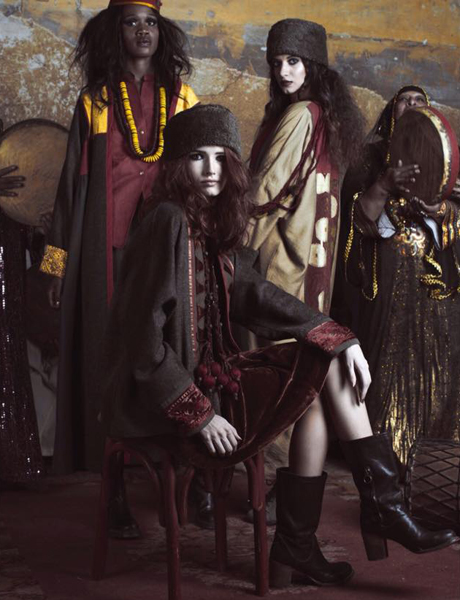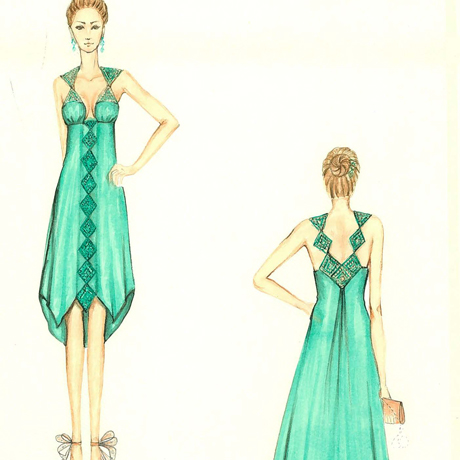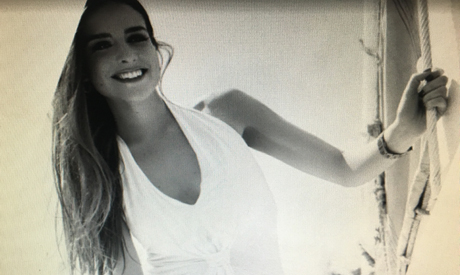With colours from the sand and skies and with soft and beautiful fabrics inspired by traditional textiles, Rola Hussein, the co-chief designer of Mix & Match has assembled her collection of dresses and loose jackets for a winter collection, which should be available at stores early November.
“We are looking at colours that match the winter mood – gold, silver and bronze essentially and a bit of champagne and deep purple,” Hussein said.

Mix&Match
Hussein, along with the original creator of Mix & Match Chahira Fahmy, took time to decide on the exact tone of the colours, and to make sure they would melt well on the fabrics they had ordered made along the lines of traditional Upper Egypt textiles.
“We are done with having fabrics imported for us or with using fabrics designed by others; we design our own fabrics to customize the material to the designs and of course we also match the colours with both,” Hussein said.
A name in women’s ready-to-wear for close to 25 years, Mix & Match presented its most welcomed collection yet last summer.
"It was very well received; it was about daring colours and sort of ethnic mixes and it did do very well at the local market – and we are successfully trying to take it to the exports scene as well,” Hussein said.
Back in the late 1980s and early 90s when Fahmy launched the business, she was one of the early comers to an almost nascent fashion scene; what she offered went beyond the basic mass production tailoring of women’s apparel.
Fahmy was not immediately interested in targeting a niche in the couture scene. She focused instead on offering Egyptian women, mostly in the 20s to 40s, a home-grown brand that suited their tastes with a diverse collection of items that could literally be mixed and matched.
For the last two years Fahmy and Hussein, who joined some 15 years ago, have been ‘up-scaling’ the brand to the higher end of ready-to-wear and closer to the couture scene.
“We are well aware of the exact scope of the Egyptian fashion industry, and we are also aware of the production capacity of our factory, but we feel that we have accumulated a particular profile for our garments that we could be branding – to put it in business terms,” Hussein said.
The Mix & Match brand for this winter, as for the last three seasons finds inspiration in the world of ethnicity, combining Asian themes with cuts and sizes to fit an Egyptian market.
Mix & Match produces apparel from size 38 – which is a bit roomy for the measurements of a French or even European 38 – to Mix & Match plus, size 54, (UK 18-20).
“Well, we come up with our sizes; but we always try to make sure that whatever we are putting in our stores is not just beautiful and comfortable but also flattering to the really diverse figures and tastes of Egyptian women,” Hussein said.
With the winter collection, Mix & Match is sticking to a tradition it started last summer, creating more overlap in the items made for regular and plus sizes.
“We want to provide a collection whereby a dress is as suitable for a size 38 as for a 54, and for a brunette as for a fair-skin lady; it is a challenge but we are coming out with it soon,” Hussein said.
The winter collection, she added, is “a capsule collection really” – essentially with dresses and a diverse selection of jackets.
“Winter in Egypt is quite short, we are really talking about ten weeks or so; and it is not very cold. So, similarly to our last winter collection, we are mostly focused on providing elegant, unique but very comfortable cover-ups rather than expanding on the basics,” Hussein said.
She admitted that this is partially an economic and business decision. With the current economic crisis it costs more to assemble the clothes, especially with the new “couture” orientation they are pursuing as part of their branding scheme. Economic conditions being what they are, people will also be shopping less.
“So I want to offer the client of Mix & Match the kind of jacket she would wear over a simple warm dress to a meeting in the afternoon and help her move through the day to maybe an early evening reception with the same simple but really distinct dress,” Hussein said.
Mix & Match has been up-scaling prices along with its styles. While this has brought a clearer identity to the brand, complemented by accessories to go with the outfits, it has also resulted in fewer stores around Cairo and Alexandria.
Hussein acknowledges the challenge of mixing the branding scheme with efforts to cater to a wider clientele. She insists, however, that what really counts most today is contributing to the growth of an Egyptian fashion industry.
Karmah Sabry, the chief designer for Sahara Collection — a more affordable store — is confident that ‘branding the Egyptian fashion industry’ is already happening.
“It is happening because more and more Egyptian women, not just in the younger age bracket as it might have been some twenty years ago, are happy wearing Egyptian through-and-through designs and fabrics,” Sabry said.
This is essentially, she argued, about the advances modern and young Egyptian designers are bringing to their customers.
According to Sabry, during the past ten years or so the gap has started to close between a traditional Egyptian dress that few women would feel comfortable wearing to their office at a bank or clinic, and more modern apparel, that keeps the 'themes and tunes' of original dress while updating it for the contemporary woman.

Photos Courtesy of: Karmah Sabry
“The fact that these designs come in perfectly soft Egyptian fabrics that really are made for the measurements of Egyptian women of all sizes is a plus,” Sabry said.
The Sahara collection is perhaps widely known for its cotton outfits that fit the summer and specifically summer vacation mood.
The last summer collection offered evidence of this with incredibly loose cotton, shirts, dresses and skirts that matched perfectly with a collection of silver jewelry. This year copper arrived as well — a less expensive metal essentially inspired by Egypt's Bedouin heritage.
“Cotton is actually so many fabrics; it can come thin or thick and is always good for our life-style; it is really our trademark,” she said.
For this winter's collection, Sabry is sticking by her "many cottons," while introducing cotton to velvet, which is also made in Egypt.
Keeping her daring and signature reds and blues, she's leaning into deeper shades for winter, and introducing warm jackets and ponchos.
“I am not sure many women go for coats for the winter in Egypt – maybe on a few days out of the season, but for the most part we are really talking jackets and ponchos,” Sabry said.
She also wants to bring in the kind of simple black dress, long for the most part, that would be complemented by a colourful jacket, “all in light but warm fabrics and in colours and designs that would travel from day to night."
Sahara is looking to late autumn for heavy business and store traffic, the time when people start opting for warmer outfits to see them through the Egyptian winter.
Sabry says the brand targets a clientele of students and working women “with a taste for clothes with style.”
Mona El-Sayed, director of the Fair Trade Egypt Project, has begun rolling out the brand's winter collection. She says she is convinced there is a growing demand for this particular kind of clothing.

Photo Courtesy of: Fair Trade Egypt
The Fair Trade Egypt (FTE) outlets, which opened first in Zamalek and then in Maadi, were among the very early places where one would find outfits observing ethnic styles from North Sinai to Siwa.
The brand began in 2000 by introducing mostly ‘typical ethnic dresses’ made by women in Sinai and Siwa. Later, they developed the designs into wider variations, bringing the original patterns and embroidery to a more sophisticated level.
“We are still keeping the very traditional dresses of the Bedouins of North Sinai and the scarves of Sohag, but we are also introducing more adjustable items – while always using fabrics made in Egypt,” El-Sayed said.
Last summer, FTE presented its customers – “not at all just expats in Egypt anymore or young women with artistic tastes,” she said – with a relatively large selection of dresses and blouses.
For this winter, she said, “we chose to present one item: a warm poncho made of the fabrics of Ahmim in Upper Egypt and embroidered with designs from North Sinai."
Given that earth colours are the theme for FTE's winter collection, which also includes home décor and copper jewelry, the ponchos come in beige, grey, café-au-lait and pale mauve.
“It is already selling very well,” said El-Sayed who introduced the collection on Saturday, 29 October.
New stylist and designer Omama El-Sheemy is convinced that there is certainly room for an emphasis on the integration of ethnic themes in the wardrobes of modern Egyptian women, from teens to those in their early 60s.
“But there are limitations because at the end of the day we cannot go ethnic all the way, neither in styles nor in embroideries,” El-Sheemy said.
Having introduced traditional crochet ornamentation to her sketches of medium length dresses, blouses and jackets, ElSheemy, says that “at the end of the day, most women still prefer the outfits presented by” the large international brands.

Photos Courtesy of: Omama El Sheemy
“You walk on the street anywhere across Cairo or for that matter across Egypt and you immediately realize that what women want to wear is a flattering pair of pants because it makes them feel comfortable and also conservative enough and a simple shirt that they can just throw in the washing machine when they go home,” ElSheemy said.
This is why, she argued, the international brands will always have a niche in the Egyptian market “especially because in many cases their garments are relatively cheap, compared to those offered by major designers in the Egyptian market".
Of course, El-Sheemy acknowledged, “the fact that most Egyptian women are veiled puts some limitations on what they can buy from many stores, especially if we are talking about the client with a limited budget.”
This is precisely the thing that makes El-Sheemy think there is a large space for new stylists and designers to begin expanding.
“I am not saying that the factories would necessarily reduce their production capacity; certainly not, especially if they opt for exports. But I think that more and more we will find small ateliers where a small group of stylists, designers and professional tailors would be catering for a limited number of clients who might not be able to cope with the prices of the international brands under the current economic crisis and who may not go for the upscale Egyptian brands which are so expensive,” El-Sheemy said.
Maria Munoz, a founding partner of Maison Pyramide, a fashion branding consultancy established in Egypt early this year, is convinced that on all tracks the fashion industry in Egypt has “incredible potential.”

Maria Munoz
This, she said is not only about the huge heritage of fabrics and designs that are inspired by many layers of Egyptian civilization, but also “the fact that there is a lot of creativity that is coming to the industry with new designers who have lots of ideas on how to cater across ranges in the market."
“Of course it is a challenge given the current economic crisis but still there is potential – for exports and also for attracting larger segments from the local market,” Munoz said.
Less than 12 months in the business, Munoz is already working with 13 companies on their branding schemes inside and outside Egypt.
Munoz knows it is probably a long shot to expect Egypt to have a ‘fashion week with defiles’ any time soon. However, she is convinced that it is only a matter of time before Egyptian designers and brands, from across the spectrum, create a niche on both the local and international market."
Short link: